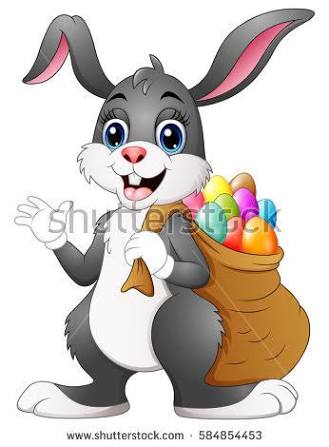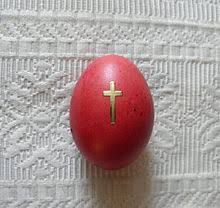Hello Steemians,so I thought to myself EASTER is really close so we all need an enlightenment on what Easter Truely means and the history of everything that is attached to it.
What is Easter?
Easter is the festival of the revival of Jesus from the tomb on the third day after his cruxifixion. Easter is the satisfied prediction of the Messiah who might be aggrieved, kick the bucket for our wrongdoings, and ascend on the third day. (Isaiah 53). Recalling the restoration of Jesus is an approach to recharge day by day trust that we have triumph over transgression.
Read the Biblical record of Resurrection Day in Matthew 28, Mark 16, and Luke 24
At the point when did Easter begin?
The early Christians started recollecting the Resurrection each Sunday following its event. In A.D. 325, the Council of Nicaea put aside an uncommon day just to commend the Resurrection. The issue with an official day was choosing whether the Resurrection ought to be praised on a weekday or dependably on a Sunday.
Numerous felt that the date should keep on being founded on the planning of the Resurrection amid Passover. Once Jewish pioneers decided the date of Passover every year, Christian pioneers could set the date for Easter by figuring three days in the wake of Passover. Following this timetable would have implied that Easter would be an alternate day of the week every year, just falling on a Sunday once in for a short time.
Others accepted since the Lord ascended on a Sunday and this day had been put aside as the Lord's Day, this was the main conceivable day to observe His resurrection. As Christianity drew far from Judaism, some were hesitant to construct the Christian festival with respect to the Jewish logbook.
At last the Council chose Easter ought to be commended on the Sunday following the primary full moon after the vernal equinox. Since the date of the vernal equinox changed from year to year, figuring the best possible date can be difficult. This is as yet the technique used to decide Easter today, which is the reason a few years we have Easter sooner than different years.
Since Easter is a festival of Jesus' Resurrection, you would think there wouldn't be space for paganism. However Easter is one of the occasions most interweaved with agnostic imagery and custom.
What Does Easter Truely Mean?
The birthplace of the word easter isn't certain. The Vernerable Bede, an eighth-century priest and researcher, proposed that the word may have originated from the Anglo-Saxon Eeostre or Eastre – a Teutonic goddess of spring and fertility. Recent researchers haven't possessed the capacity to discover any reference to the goddess Bede specified and consider the hypothesis ruined.
Another probability is the Norse eostur, eastur, or ostara, which signified "the period of the developing sun" or "the period of new birth." The word eastcomes from the same roots. In this case, easter would be connected to the changing of the season.
A later and complex clarification originates from the Christian foundation of Easter as opposed to the pagan. The early Latin name for the seven day stretch of Easter was hebdomada alba or "white week," while the Sunday after Easter day was called dominica in albis from the white robes of the individuals who had been recently baptized. The word alba is Latin both for white and dawn. People speaking Old High German committed an error in their interpretation and utilized a plural word for dawn, ostarun, instead of a plural for white. From ostarun we get the German Ostern and the English Easter.
.jpg)
Link
Origin And The Story Behind The Easter Bunny
What is the principal thing that strikes a chord when you consider Easter? As a Christian, the primary picture may be the cross or the purge tomb. For the overall population, a barrage of media pictures and stock on store racks makes it more probable that the Easter Bunny comes to mind. So how did a rabbit appropriating eggs turn into a piece of Easter?
There are a few explanations behind the rabbit, or bunny, to be related with Easter, all of which come through agnostic festivals or beliefs. The most clear is the rabbit's fertility. Easter comes amid spring and celebrates new life. The Christian significance of new life through Christ and a general accentuation on new life are extraordinary, however the two step by step merged. Any creatures – like the bunny – that delivered numerous posterity were anything but difficult to incorporate.
The rabbit is likewise an old image for the moon. The date of Easter relies upon the moon. This may have helped the bunny to be assimilated into Easter festivals.
The bunny or rabbit's tunnel helped the creature's selection as a component of Easter celebrations. Believers saw the rabbit leaving its underground home as an image for Jesus leaving the tomb. Perhaps this was another instance of taking a prior image and giving it Christian importance.
The Easter bunny came to America with German outsiders, and the rabbit's part passed to the regular American rabbit. Originally kids made homes for the rabbit in caps, caps, or favor paper boxes, instead of the bushels of today. Once the kids completed their homes, they place them in an isolates spot to keep from startling the modest rabbit. The engaging homes loaded with shaded eggs most likely helped the traditions to spread.
.jpeg)
Link
Back in Southern Germany, the principal cake and treat Easter bunnies wound up prevalent toward the start of the nineteenth century. This custom likewise crossed the Atlantic, kids still eat confection rabbits – especially chocolate ones – at Easter.
Inception and history of Easter Eggs
.jpeg)
Link
Beside the Easter bunny, the most commonplace image is the Easter egg. Like others, the egg has a long pre-Christian history. Again there's no assurance regarding why it moved toward becoming related with Easter.
Numerous Ancient societies saw eggs as an image of life. Hindus, Egyptians, Persians, and Phoenicians trusted the world started with a colossal egg. The Persians, Greeks, and Chinese gave endowments of eggs amid spring celebrations in festivity of new life all around them. Other sources say individuals ate colored eggs at spring celebrations in Egypt, Persia, Greece, and Rome. In antiquated Druid legend, the eggs of serpents were consecrated and remained forever.
Early Christians took a gander at the association eggs needed to life and chose eggs could be a piece of their festival of Christ's resurrection. In expansion, in a few territories, eggs were prohibited amid Lent; in this way, they were a delicacy at Easter. Since a large number of the prior traditions were Eastern in starting point, some hypothesize that early preachers or knights of the Crusade may have been in charge of conveying the custom toward the West.
In the fourth century, individuals displayed eggs in chapel to be honored and sprinkled with heavenly water. By the twelfth century, the Benedictio Ovorumhad been presented approving the extraordinary utilization of eggs on the sacred days of Easter. The timing of this gift would maintain the possibility that Crusaders may have brought the convention back. Even however eggs had been utilized already, the Crusaders may have made the custom more prominent and boundless.
In 1290, Edward I of England recorded a buy of 450 eggs to be shaded or secured with gold leaf. He at that point gave the eggs to individuals from the illustrious family.
Once the custom ended up acknowledged, new conventions started to grow up around it. Eggs were colored red for delight, and in memory of Christ's blood. Egg moving challenges came to America from England, potentially as an indication of the stone being moved away.
Shouldn't something be said about the commonplace Easter Egg hunt? One source recommended that it became out of the custom of German youngsters looking for concealed pretzels amid the Easter season. Since kids were concealing homes for the Easter Bunny to load with eggs in the meantime they were chasing pretzels, it was just a little jump to start concealing eggs.
.jpeg)
Link
The Easter Lamb
.jpeg)
Link
Of every single Easter image, the sheep is likely the most unequivocally Christian. Other than the way that sheep are youthful creatures conceived in springtime, it has no solid connections to agnostic conventions.
The sheep originates from the Jewish Passover, where every family executed a sheep as a sacrifice. When Christ turned into the Passover Lamb for everybody, the sheep turned into an image for His forfeit.
John 1:29 -"The following day John saw Jesus coming toward him and stated, "Look, the Lamb of God, who takes away the transgression of the world!"
1 Peter 1:18-21 -"For you realize that it was not with perishable things, for example, silver or gold that you were recovered from the void lifestyle passed on to you from your predecessors, however with the valuable blood of Christ, a sheep without imperfection or deformity. He was picked before the production of the world, however was uncovered in these last circumstances for your purpose. Through him you have confidence in God, who raised him from the dead and celebrated him, thus your confidence and expectation are in God."
New Clothes at Easter
New garments have for quite some time been related with the possibility of originality and a crisp beginning. The natural custom of having new garments for Easter most likely started with early Christians wearing new white robes for baptism during Easter Vigil services. Later, the exceptionally extended to everybody wearing new garments in festivity of his or her new life in Christ.
Dawn Services
The recognizable dawn benefit is a moderately new expansion to Easter. A gathering of youthful Moravian men in Hernhut, Saxony held the main recorded dawn benefit in 1732. They went to their burial ground called God's Acre at dawn to revere in memory of the ladies who went to the tomb at an early stage the primary Easter morning and found it empty. Moravian outsiders conveyed the custom to America, with the principal benefit in the United States held in 1743.
Easter Lilies
The Easter lily is another new expansion to Easter festivals. Consistently, painters and stone carvers utilized the white Madonna lily to symbolize virtue and honesty, every now and again alluding to Mary. This lily doesn't constrain well, so nurseries couldn't get the blossom to sprout in time Easter.
In the 1880s, Mrs. Thomas Sargent took Bermuda lily knobs back to Philadelphia. A neighborhood nurseryman, William Harris, saw the lilies and acquainted them with the exchange. A more useful thought was that they were anything but difficult to compel into sprout in time for the Easter season. From there, they Bermuda lily, now the recognizable Easter lily, spread all through the nation.
Please Pray This Prayer During The Easter Sunday
A Prayer For Easter Sunday
Ruler God,
You adored this world to such an extent,
That you gave your unrivaled Son,That we may be called your youngsters as well.
Ruler, help us to live in the joy and beauty Of Easter Sunday, ordinary.
Give us a chance to have hearts of appreciation
For your forfeit.
Give us a chance to have eyes that view
Your effortlessness and celebrate in our salvation.
Help us to stroll in that relentless elegance
What's more, advise your uplifting news to the world.
Just for your magnificence do we supplicate, Lord
So be it...
Amen
HAPPY EASTER IN ADVANCE
.jpeg)